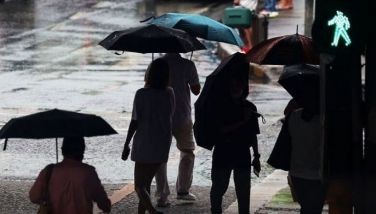Why not have a separate cemetery for historic Filipinos?

MANILA, Philippines - Senate President Aquilino Pimentel III is seeking the establishment of a separate cemetery for “historic Filipinos” amid the outrage over the surprise burial of the late strongman Ferdinand Marcos at the Libingan ng mga Bayani (LNMB).
Pimentel filed on Friday Senate Bill 1246, on the same day Marcos was interred under surreptitious circumstances at the LNMB.
His proposal was entitled “An Act Segregating Parcels of Land within the Libingan ng mga Bayani Allocated for the Remains of Filipino Historical Figures to be known as the Libingan ng mga Makasaysayang Pilipino.”
“This could be a good answer to a raging issue, where everyone is fixated on the name of a place (LNMB). So I hope we could accept the idea of segregation or even find another burial place as a next step,” Pimentel told radio dwIZ yesterday.
He said if his proposed burial place were created before, probably the issue of where Marcos should be buried would not have dragged on for decades.
Pimentel, an ally of President Duterte, strongly opposed the burial of Marcos at LNMB. He voted for the resolution expressing the sense of the Senate against the Supreme Court ruling allowing the burial.
He said Duterte is fully aware of his opposition but “this is a decision only a president can make.”
Pimentel’s bill seeks to set aside the land within the LNMB where Filipinos of historical interest, such as presidents of the Philippines, statesmen, dignitaries and national artists and scientists, are interred, into a cemetery separate from the remains of those who served in the military.
This cemetery will be called the Libingan ng mga Makasaysayang Pilipino, or LNMP.
In 1948, a year after the establishment of the LNMB, Republic Act 248 was enacted, which mandated the construction of a National Pantheon where remains of all presidents of the Philippines, national heroes and patriots would be interred to perpetuate their memory for the inspiration and emulation of generations of Filipinos.
“Since no new National Pantheon was constructed pursuant to the said law, LNMB served as the National Pantheon envisioned under the law to be the burial place of the mortal remains of all the presidents of the Philippines, national heroes and patriots,” Pimentel said in his bill.
He said this is the reason why Armed Forces of the Philippines Regulation G 161-375 included Filipinos of historical interest and others to be interred in the LNMB alongside the remains of those with military service.
If passed into law, the bill will preserve the LNMB as a military memorial consistent with the purpose intended for it when it was established in 1947 as the Republic Memorial Cemetery.
The Republic Memorial Cemetery was renamed the Libingan ng mga Bayani in 1954 through Proclamation No. 86 of then President Ramon Magsaysay.
- Latest
- Trending




























